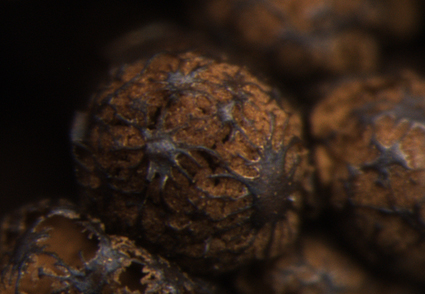Abstract
Lycogala is one of the most widely known genera of myxomycetes due to its distinct characteristics and cosmopolitan distribution. This study introduces a new species, Lycogala heterospora, based on its morphological characteristics and molecular analyses using the small subunit of the ribosomal RNA (nrSSU) gene. It is characterized by its spores of varying sizes and yellowish-brown peridial vesicles. The characteristics of the new species were examined under a stereomicroscope and a light microscope. The micrographs of relevant details are included. Moreover, Lindbladia cribrarioides is documented for the first time in China.
References
- Dai, D., Xu, X.Q., Wang, S.Y., Liang, Y., Li, Y. & Zhang, B. (2019) The Life Cycle of Myxogastria. Journal of Fungal Research 17: 116–124. [in Chinese]
- Emoto, Y. (1977) The Myxomycetes of Japan. Sangyo Tosho, Tokyo, 30–31 pp.
- Hall, T. (2011) BioEdit: an important software for molecular biology. GERF Bulletin of Biosciences 2: 60–61.
- Katoh, K. & Standley, D.M. (2013) MAFFT Multiple Sequence Alignment Software Version 7: Improvements in Performance and Usability. Molecular biology and evolution 30: 772–780. https://doi.org/10.1093/molbev/mst010
- Lado, C. (2005–2023) An online nomenclatural information system of Eumycetozoa. Available from: https://eumycetozoa.com (accessed: 26 September 2023)
- Leontyev, D.V., Buttgereit, M., Kochergina, A., Shchepin, O. & Schnittler, M. (2023b) Two independent genetic markers support separation of the myxomycete Lycogala epidendrum into numerous biological species. Mycologia 115: 32–43. https://doi.org/10.1080/00275514.2022.2133526
- Leontyev, D.V., Ishchenko, Y. & Schnittler, M. (2023a) Fifteen new species from the myxomycete genus Lycogala. Mycologia 11: 524–560. https://doi.org/10.1080/00275514.2023.2199109
- Leontyev, D.V., Schnittler, M., Ishchenko, Y., Quade, A., Kahlert, H., Rojas Alvarado, C. & Stephenson, S.L. (2022) Another species complex in myxomycetes: diversity of peridial structures in Lycogala epidendrum. Nova Hedwigia 114: 413–434. https://doi.org/10.1127/nova_hedwigia/2022/0690
- Leontyev, D.V., Schnittler, M. & Stephenson, S.L. (2015) A critical revision of the Tubifera ferruginosa complex. Mycologia 107: 959–985. https://doi.org/10.3852/14–271
- Leontyev, D.V., Schnittler, M., Stephenson, S.L., Novozhilov, Y.K. & Shchepin, O.N. (2019) Towards a phylogenetic classification of the Myxomycetes. Phytotaxa 39: 209–238. https://doi.org/10.11646/phytotaxa.399.3.5
- Li, M., Tao, X., Li, B., Du, Q., Zhu, X.Q., Huang, D.M., Yan, S.Z. & Chen, S.L. (2021) Spatiotemporal distribution and dynamic changes of myxomycetes in subtropical forests of China. Fungal Ecology 53: 101078. https://doi.org/10.1016/j.funeco.2021.101078
- Li, Y., Li, H.Z., Wang, Q. & Chen, S.L. (2008) Flora Fungorum Sinicorum Myxomycetes. Science Press, Beijing, 25 pp. [in Chinese]
- McHugh, R. & Reid, C. (2008) Aethalium cortex formation in the myxomycete Lycogala terrestre. Revista Mexicana de Micologia 27: 53–57.
- Nguyen, L.-T., Schmidt, H.A., Von Haeseler, A. & Minh, B.Q. (2015) IQ-TREE: A fast and effective stochastic algorithm for estimating maximum-likelihood phylogenies. Molecular biology and evolution 32: 268–274. https://doi.org/10.1093/molbev/msu300
- Rambaut, A. (2018) FigTree 1.4.4. Available from: http://tree.bio.ed.ac.uk/software/figtree (accessed: 23 May 2023)
- Stephenson, S.L. (2021) Secretive slime moulds, Myxomycetes of Australia. ABRS, Canberra & CSIRO, Melbourne, 29 pp. https://doi.org/10.1071/9781486314140
- Takahashi, K. & Hada, Y. (2010) Geographical distribution of myxomycetes on coniferous deadwood in relation to air temperature in Japan. Mycoscience 51: 281–290. https://doi.org/10.1007/S10267-010-0044-9
- Wang, W., Wang, W., Wei, S.W., Huang, W., Qi, B., Wang, Q. & Li, Y. (2021) Design of potentially universal SSU primers in myxomycetes using next-generation sequencing. Journal of Microbiological Methods 184: 106203. https://doi.org/10.1016/j.mimet.2021.106203
- Wijayawardene, N.N., Hyde, K.D., Dai, D.Q., Sánchez-García, M., Goto, B.T., Saxena, R.K., Erdoğdu, M., Selçuk, F., Rajeshkumar, K.C., Aptroot, A., Błaszkowski, J., Boonyuen, N., da Silva, G.A., de Souza, F.A., Dong, W., Ertz, D., Haelewaters, D., Jones, E.B.G., Karunarathna, S.C., Kirk, P.M., Kukwa, M., Kumla, J., Leontyev, D.V., Lumbsch, H.T., Maharachchikumbura, S.S.N., Marguno, F., Martínez-Rodríguez, P., Mešić, A., Monteiro, J.S., Oehl, F., Pawłowska, J., Pem, D., Pfliegler, W.P., Phillips, A.J.L., Pošta, A., He, M.Q., Li, J.X., Raza, M., Sruthi, O.P., Suetrong, S., Suwannarach, N., Tedersoo, L., Thiyagaraja, V., Tibpromma, S., Tkalčec, Z., Tokarev, Y.S., Wanasinghe, D.N., Wijesundara, D.S.A., Wimalaseana, S.D.M.K., Madrid, H., Zhang, G.Q., Gao, Y., Sánchez-Castro, I., Tang, L.Z., Stadler, M., Yurkov, A. & Thines, M. (2022) Outline of Fungi and fungus-like taxa–2021. Mycosphere 13: 53–453. https://doi.org/10.5943/mycosphere/13/1/2
- Zhang, Z., Chuang, Y.-H., Huang, N. & Mitch, W.A. (2019) Predicting the contribution of chloramines to contaminant decay during ultraviolet/hydrogen peroxide advanced oxidation process treatment for potable reuse. Environmental science & technology 53: 4416–4425. https://doi.org/10.1021/acs.est.8b06894
- Zhao, H.N., Rao, G., Yang, X.Y., Li, X., Yu, H., Zhang, B. & Li, Y. (2022) Two new species of Diderma (Physarales, Didymiaceae) from northern China. Phytotaxa 572: 61–73. https://doi.org/10.11646/phytotaxa.572.1.4
- Zhao, H.N., Xu, X.Q., Dai, D., Wang, S.Y. & Bo, Z. (2022) Review on Moist Chamber Cultures of Myxomycetes. Journal of Fungal Research 20: 51–64. [in Chinese]


